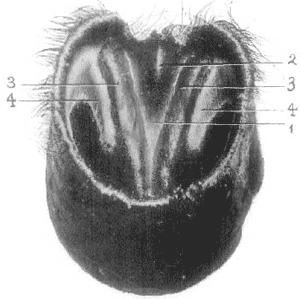The frog of the hoof
 The frog of the hoof is triangular or pyramidal in shape, the frog bears a close resemblance to the form of the plantar cushion, upon the lower surface of which body it is moulded. It offers for consideration two faces, two sides, a base, and a point or summit.
The frog of the hoof is triangular or pyramidal in shape, the frog bears a close resemblance to the form of the plantar cushion, upon the lower surface of which body it is moulded. It offers for consideration two faces, two sides, a base, and a point or summit.FIG. 22.—HOOF WITH THE SENSITIVE STRUCTURES REMOVED. 1, Superior face of horny frog; 2, the frog-stay; 3, the lateral ridges of the frog's superior surface; 4, the horny laminæ at the inflections of the wall.
The Superior Face is an exact cast of the lower surface of the plantar cushion. It shows in the centre, therefore, a triangular depression, with the base of the triangle directed backwards.
Posteriorly, the depression is continued as two lateral channels divided by a median ridge. The median ridge widens out as it passes backwards, forming the larger part of the posterior portion of the frog. This median ridge fits into the cleft of the plantar cushion. It serves to prevent displacement of the sensitive from the horny frog, and has been rather aptly termed the 'Frog-stay.'
The Inferior Surface is an exact reverse of the superior. The triangular depression of the superior surface is represented in the inferior surface by a triangular projection, and the ridge-like frog-stay of the upper surface is represented below by a median cleft, the Median Lacuna of the frog.
The triangular projection in front of the median lacuna is the body or cushion of the frog. It is continued backwards as two ridge-like branches, which, at the points of the heels, form acute angles with the bars. On the outer side of each lateral ridge is a fissure. These are known as the Lateral Lacunæ.
The Sides of the frog are flat and slightly oblique. They are closely united to the bars and to the triangular indentation in the posterior border of the sole.
The Base of the frog is formed by the extremities of its branches, which, becoming wider and more convex as they pass backwards, form two rounded, flexible, and elastic masses separated from each other by the median lacuna. These constitute the 'glomes' of the frog. They are continuous with the periople.
The Point of the Frog is situated, wedge-like, within the triangular notch in the posterior border of the sole.